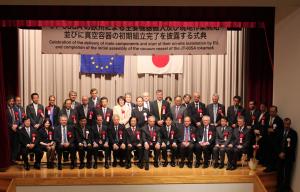At JT-60SA also, components are arriving
7 Jun 2015
-
Hisato Kawashima, Project Team, Satellite Tokamak Programme, Broader Approach
The ceremony on 20 April gathered high-ranking members of the Japanese government, European embassies and the European Commission, as well as representatives of the industries and institutions participating in the JT-60SA program. Far right: Yutaka Kamada, the Japanese home team project manager; and Pietro Barabaschi, the European home team project manager and acting Director of the European Domestic Agency for ITER.
On 20 April 2015, the Japan Atomic Energy Agency (JAEA) welcomed 200 guests for a celebration of progress-to-date in the JT-60SA development program in Naka, Japan.
JT-60SA is a fusion experiment designed to support the operation of ITER and to investigate how best to optimize the operation of fusion power plants that are built after ITER. It is a joint international research and development project involving Japan and Europe, using infrastructure of the existing JT-60 Upgrade experiment. SA stands for "super, advanced", since the experiment will have superconducting coils and study advanced modes of plasma operation. This satellite tokamak program was established in 1997 as one of three joint projects between Europe and Japan within the Broader Approach Agreement.
Since the JT-60SA construction started on 28 January 2013 with the installation of the cryostat base, fabricated in Spain, the project has been making steady progress toward the start of fusion plasma experiments in 2019. In September 2014, quench protection circuits, a power supply system made in Italy, were delivered to the JAEA Naka site and their on-site installation and commissioning by European workers continues to the present. In April 2015, the refrigerator cold box and the auxiliary cold box for cryogenic system—two components fabricated in France—were also delivered and their installation is ongoing. The first pair of high temperature superconductor current leads for the toroidal field coils made in Germany has also reached Naka. In the torus hall, since May 2014, the vacuum vessel sectors manufactured in Japan have been mounted on the cryostat base and are now being welded together to form the 340° of the torus.
The day-long ceremony, which celebrated the delivery of main components, the start of their on-site installation by Europe, and the completion of the initial assembly of the vacuum vessel, was also the occasion to promote further partnership among the governments, organizations, institutes, universities and companies concerned in both Europe and Japan as well as local governments, which strongly support and contribute to the JT-60SA project.
For more information and the latest news, please visit the JT-60SA website.


